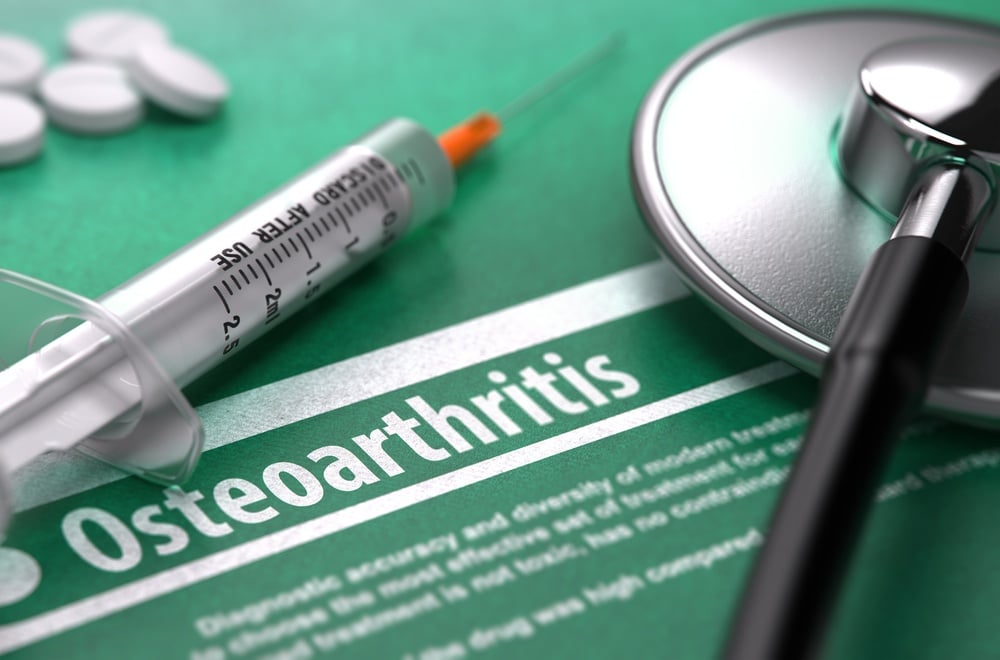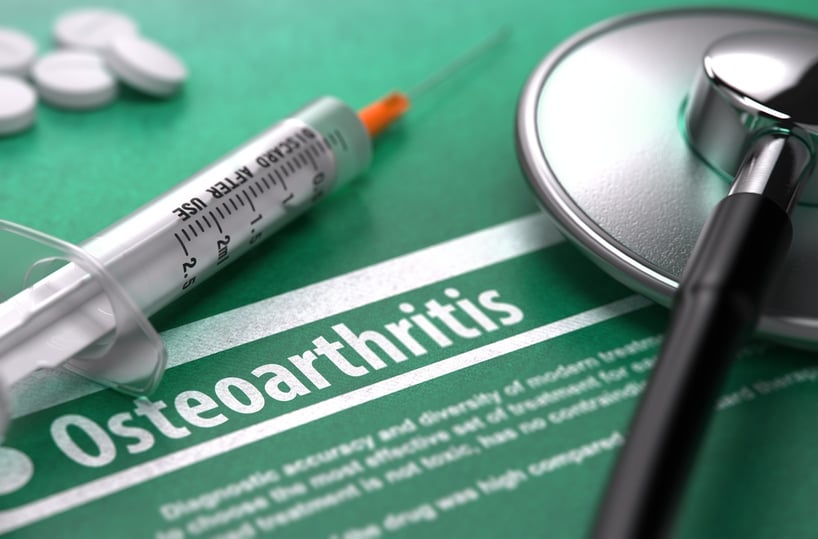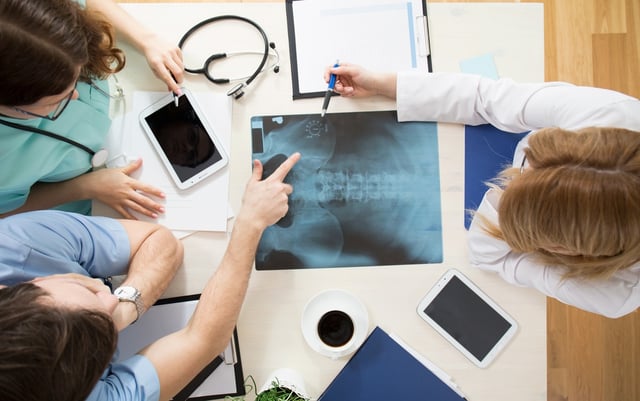Treatment options for Osteoarthritis: Exercise, Medications, Surgery
June 6th, 2016 | 4 min. read


Osteoarthritis (OA) is the most common degenerative condition affecting the joints. About 27 million people in the U.S. have some form of OA, which is a breakdown of joint cartilage that can lead to pain, swelling, and stiffness. OA is a long-term, incurable disease; you can't reverse its effects, but you can learn strategies and options for managing your symptoms.
Joints Affected by OA

Osteoarthritis is common as we age, but it can also happen to younger people (even teens!) who've suffered significant wear and tear in their joints due to sports injuries. OA can happen to any joint in the body, but it's most common in:
- elbows
- feet (ankles and toes)
- hands (and fingers)
- hips
- knees
- shoulders
- spine (back and neck)
- wrists
How do you know if you have OA? Specific symptoms vary depending on the location, but generally can include:
- bumps or nodules on the fingers or toes
- deformity of the joint
- difficulty sitting for long periods
- grinding or crackling in the joint
- limping or limited motion
- pain (moderate to severe), especially at the end of the day
- pain that is worse in cold or damp weather
- stiffness, more pronounced in the morning
- swelling
- tenderness
- warmth over the joint area
Osteoarthritis can be painful and disruptive to your life, but you can take steps to improve your symptoms and stay healthy. Management of osteoarthritis often involves using several strategies, including exercise, medication, and surgery, to help maintain mobility and function and to reduce pain.
exercises that may help OSTEOARTHRITIS

Though it may seem counterintuitive when you're in pain and have stiffness and mobility issues, moving and staying active are very important parts of treating arthritis.
Studies show that exercise can reduce pain and keep your weight under control. Keeping at a healthy weight means less wear and tear on your joints (especially spine, hips, knees, and feet/ankles).
Strengthening and stretching the muscles around your OA-affected joints can have several other benefits:
- Strong muscles help support the joints and remove some of the burden from them.
- Stretching can improve flexibility and range of motion.
- Regular movement may help to reduce stiffness.
Examples of gentle, low-impact exercises that may be suitable for arthritis patients include:
- Aquatherapy or aqua aerobics (performing resistance and aerobic exercises in a swimming pool)
- Biking or using a recumbent or stationary bike
- Dance classes, low-impact (like ballroom dance)
- Stretching moves that incorporate breathing exercises, like tai chi, qigong, and yoga
- Swimming
- Walking
- Weight training
Many other activities may work for you, depending on your condition, general health, and age. Whatever activity you choose, try to exercise 150 minutes per week, and talk to a doctor first about helping you devise a safe and beneficial exercise program.
MEDICATIONS FOR OSTEOARTHRITIS

For many, treating arthritis symptoms is a multi-pronged approach that includes a combination of movement therapies (exercise, yoga, stretching, etc.) and medication.
There is no one "best pain reliever for osteoarthritis" — every patient is different. Talk to your doctor about which of the following medication approaches may work best for you:
- Over-the-counter (OTC) drugs. For milder symptoms, taking acetaminophen (Tylenol) or NSAIDs (non-steroidal anti-inflammatory drugs) like aspirin, ibuprofen, naproxen, or celecoxib may help to relieve your pain and swelling. Some people may also get relief from topical analgesics (pain-relievers) in the form of patches or creams.
- Prescription medications. For more severe pain, a doctor may prescribe a stronger dose of NSAIDs or analgesics (pain-relievers) like opioids. Certain antidepressants like duloxetine (Cymbalta) have also shown to have good results in treating chronic pain in some people.
- Corticosteroids. Corticosteroids are anti-inflammatory medications that can be prescribed in pill form or delivered via injection directly into a joint. Corticosteroids injections can be delivered in your doctor's office.
- Hyaluronic acid injections. This naturally-occurring joint fluid cushions and lubricates the joints. If you have osteoarthritis, however, you may be suffering from a breakdown of this acid. Injections of this lubricant, given by a doctor, may help to reduce pain and restore mobility.
Talk to your doctor about benefits, side effects, and interactions with any other medications you may be taking.
SURGERY FOR OSTEOARTHRITIS
The decision to treat osteoarthritis with surgery is a personal one. Pain tolerances vary and people have different feelings about what is an acceptable and endurable amount of discomfort and disability.
If you are considering surgery, you might benefit if you meet the following criteria.
Signs you may benefit from osteoarthritis surgery
- You're in good health. (Ask your doctor.)
- Your cartilage loss is significant.
- Your pain is severe.
- Other therapies, medications, and treatments haven't helped alleviate your symptoms.

Depending on factors like your age, activity level, general health, and of course the location of osteoarthritis in your body, you have different options for surgical treatment of arthritis.
1. Arthroscopy
Arthroscopic surgery can help some patients to move their joints better. In this minimally invasive procedure, your orthopedist will use a scope with a camera to see inside your joint. Tiny surgical instruments can be inserted to smooth over rough areas and remove loose cartilage or bone that may be causing pain or inflammation. Arthroscopy is frequently performed on the knee, shoulder, ankle, and wrist.
2. Computer-assisted hip surgery
-
Hip resurfacing (arthroplasty) is often used for people with serious hip damage and pain who are not ready for, or do not yet need, an entire hip replacement. This procedure is most often performed on people under the age of 60. An orthopedist can replace only the damaged surfaces of the bone (ball or socket, or both) with a metal, plastic, or ceramic surface.
-
Osteotomy, like hip resurfacing, corrects specific defects without replacing the entire joint. In this procedure, your orthopedist will remove or add a piece of bone to your damaged joint to help shift your body weight to an area where there is more healthy cartilage. Osteotomy is most often used to treat arthritis in the hip and knee, usually in active people under 60 who wish to delay more serious surgery like joint replacement.
3. Joint fusion (arthrodesis)
In this procedure, your orthopedist fuses two eroded bones together to form one larger segment of bone. This eliminates the joint, preventing bending. To stimulate healing and secure the fusion, surgery may require bone grafts or the insertion of implants like plates, wires, or screws.
Joint fusion is often used to treat arthritis in the vertebrae (spine), ankles, hands, and feet. Less often, doctors can fuse knees and hips as well. Fusion may help to reduce your pain, but you will lose a certain degree of mobility. Your doctor may pair your joint fusion with bone growth stimulation therapy to help speed your recovery.
4. Joint replacement
The most common joint replacement procedures are hip replacement surgery and total knee replacement. Shoulder, wrist, and ankle replacement surgeries are also common.
Most important is that you don't suffer alone. An orthopedist can help you discuss your options and create a plan for managing your osteoarthritis symptoms. Give Coastal Orthopedics located in Corpus Christi, TX a call and ask for a consultation. Telephone: 361.994.1166.
Dr. Williams has been practicing orthopedic surgery in Corpus Christi since 1998. After graduating from Texas Tech hereceived his medical degree from the University of Texas at San Antonio. At the prestigious Campbell Clinic located at the University of Tennessee, Dr. Williams completed not only an Orthopedic Surgery Residency, but an additional year of Fellowship Training in Spine Surgery. Dr. Williams is dedicated to creating an excellent patient experience in the office or in the surgery suite.
Topics:
